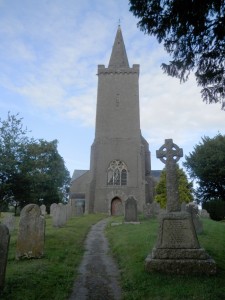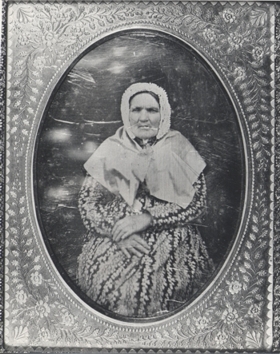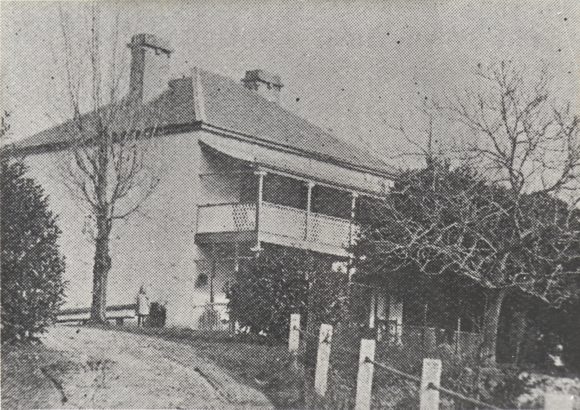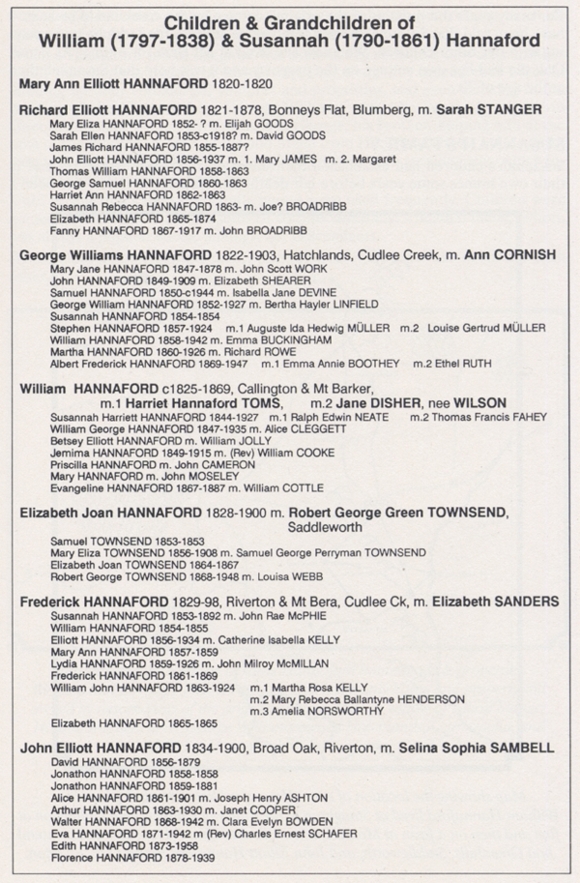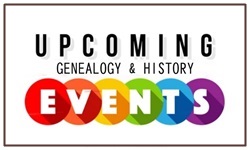Australia Day Blog Challenge: Climbing Your Family’s Gum Tree
I do love a good geneameme, so when Shauna Hicks posted her Australia Day post recently, which ended up being a revisit of an Australia Day Blog Challenge that was created by fellow Aussie geneablogger, Pauleen Cass a number of years ago, which apparently I missed … the challenge was on!!
Pauleen says …
“The geneameme is to test whether your family is ridgey-didge and to show us how Australia runs in your veins, without any flag-waving and tattoo-wearing. Shout it out, be proud and make everyone wish they lived in this wide brown land of ours.”
1. My first ancestor to arrive in Australia was …
Ok, if we count “what’s yours is mine” when you get married – Mr Lonetester’s convict, John Warby, who was given a free ticket to Australia in 1792, is my earliest ancestor. You can read more about him here. However ‘my’ own first ancestor would be Isaac and Simeon Richardson. They are two brothers who were labourers from Kent, and were sentenced to death for their part in local riots, however thanks to the local townsfolk, their life was spared, and instead they were transported to Van Diemen’s Land (for more click here). But my first non-convict ancestor was my Randell family from Devon to South Australia in 1837 (click for more details). Based on my Randell family, i’m 6th generation Australian.
2. I have Australian Royalty (tell us who, how many and which Fleet they arrived with) …
OK, I don’t have any first, second or even third fleet convicts, but I do have Australian Royalty.
Isaac RICHARDSON, transported 1831, Lord Lyndoch
Simeon RICHARDSON, transported 1831, Lord Lyndoch
William COSGROVE (still not 100% proven, but seems highly likely)
So that was my direct lot now on to Mr Lonetester’s gang of Australian Royalty …
John WARBY, transported 1792, Pitt
Sarah BENTLEY, transported 1795-06, Indispensible
Isaac DOWSE, transported 1802-03, Glatton
Esther Jane JENNER, transported 1807, Sydney Cove
Alexander MACDONALD, transported 1812-13, Fortune
Elizabeth SYMONS, transported 1814, Broxbornebury
James LAYTON, transported 1814-15, Marquis of Wellington
Charles BILLING, transported 1835, Norfolk
Frederick POINTON, transported 1836-37, Sarah
Henry POINTON, transported 1836-37, Sarah
Charles KERSLAKE, transported 1837, Moffatt
Sarah Jane BROWN, transported 1838-39, Majestic
Thomas POINTON, transported 1840, Lady Raffles
Isobel CUTHBERT, transported 1844, Margaret
Louisa WRIGHT, transported 1844-45, Garland Grove
James DODD, transported 1852-53, Oriental Queen
For more on all of these, head on over to this post.
3. I’m an Aussie mongrel, my ancestors came to Oz from…
Mostly England and Ireland, but there is also some German, Dutch and Finnish mixed in there.
4. Did any of your ancestors arrive under their own financial steam?
Pretty sure most of them made their own way here. Though see Q2 for the convicts who got a free ticket here, but then there’s also my great grandpa who was a seaman and jumped ship in Queensland!
5. How many ancestors came as singles?
You know , I’ve never actually counted! I will do that someday .. just not today
6. How many came as couples?
As above … I haven’t counted.
7. How many came as family groups?
I definitely know that some came out as families – such as my Hannaford’s and Randell’s from Devon, and the Phillips family from Cornwall. But people think travelling for a day or so on a plane with kids now is hard! Try 3 months in a ship!! I can’t even begin to imagine.
8. Did one person lead the way and others follow?
Hmmm … I know that happened with a family that went from Cornwall, England to the US. The dad went first, and was followed by his wife and kids later. But no-one comes to mind that came to Australia.
9. What’s the longest journey they took to get here?
For this one I need to go to Mr Lonetester’s family history again, as he has one that takes the cake! His William Kennard Elphick and his wife Susanna Elphick (nee Elliot), sailed on the ‘Plantar’ ship from London to South Australia in 171 days (25 November 1838 – 15 May 1839). Yes, that’s nearly SIX MONTHS!! Why did it take so long? Well thanks to a diary that a fellow passenger kept, and it’s been preserved … but with a mutiny, a lost crew, captain missing a key port and then almost running out of food, almost running aground … and so it goes on. Anything that could happen on a voyage, DID happen on this one. For more about it you can read my original post here. And the State Library of South Australia have digitised the original, and made it available online, which is viewable here.
10. Did anyone make a two-step emigration via another place?
Not that I know of.
11. Which state(s)/colony did your ancestors arrive?
Mine were pretty much all South Australian immigrants, apart from the convict brothers who went (and by went, I mean sent) to Tasmania.
12. Did they settle and remain in one state/colony?
Most of my reli’s came to South Australia, and certainly the greater portion of them stayed. A few of the wider then went off to different states, but my direct reli’s stayed!
13. Did they stay in one town or move around?
If we’re talking about my direct family – they settled in the Adelaide Hills, stayed there, and family (including myself) still live in the vicinity.
14. Do you have any First Australians in your tree?
Not that I’ve found so far.
15. Were any self-employed?
I think most of them were self-employed actually.
16. What occupations or industries did your earliest ancestors work in?
Farmers, Orchardists, Flour-millers, River-boat builders and captains, Fruit market sellers. That’s the ones that comes to mind at present …
17. Does anyone in the family still follow that occupation?
I have a cousin who is a 5th generation apple orcharder in the Adelaide Hills! So that’s seriously awesome.
18. Did any of your ancestors leave Australia and go “home”?
Not that I’ve found so far!
There were a few more questions in Pauleen’s original post, but that was about current stuff, not my ancestors, so I opted to leave those out for now. So that’s a little about some of my Australian ancestors …
Clearly there are some bits I need to do more research on – so I’ll add that to the to-do list, and I’ll get to it one day.
Australia Day – We Are Australian
For Australia Day this year I wanted to share with you a song that I love, and embraces everything about Australia … “I am Australian”. From the Aboriginals who of course were the first settlers, to the convicts and the free. The goldiggers and bushrangers, to the Anzacs and recent migrants … all of them, is what makes Australia the amazing, multi-cultural country it is today, and they all get a mention in this song.
Personally I am a 6th generation Australian, whose roots lie in many countries around the world. I am Australian!
I am Australian
I came from the dream-time, from the dusty red soil plains
I am the ancient heart, the keeper of the flame.
I stood upon the rocky shore, I watched the tall ships come.
For forty thousand years I’ve been the first Australian.
I came upon the prison ship, bowed down by iron chains.
I fought the land, endured the lash and waited for the rains.
I’m a settler, I’m a farmer’s wife on a dry and barren run
A convict then a free man, I became Australian.
I’m the daughter of a digger who sought the mother lode
The girl became a woman on the long and dusty road
I’m a child of the depression, I saw the good times come
I’m a bushy, I’m a battler, I am Australian
We are one, but we are many
And from all the lands on earth we come
We share a dream and sing with one voice:
I am, you are, we are Australian
I’m a teller of stories, I’m a singer of songs
I am Albert Namatjira, and I paint the ghostly gums
I am Clancy on his horse, I’m Ned Kelly on the run
I’m the one who waltzed Matilda, I am Australian
I’m the hot wind from the desert, I’m the black soil of the plains
I’m the mountains and the valleys, I’m the drought and flooding rains
I am the rock, I am the sky, the rivers when they run
The spirit of this great land, I am Australian
We are one, but we are many
And from all the lands on earth we come
We share a dream and sing with one voice:
I am, you are, we are Australian
I am, you are, we are Australian!
We are one, but we are many
And from all the lands on earth we come
We share a dream and sing with one voice:
I am, you are, we are Australian
I am, you are, we are Australian!
Lyrics written in 1987 by Bruce Woodley of ‘The Seekers’ and Dobe Newton of ‘The Bushwackers’ and set to music composed by Bruce Woodley.
21 Facts About the First Fleet
Did you know that approximately 20% of Australians descend from convicts … yes, true! Having a convict in the family has become a badge of honour for many, and having a First Fleeter even more so.
And while the term ‘convict’ tends to mean ‘criminal’, so many of the 162,000 who were transported to Australia weren’t actually ‘bad’. In fact, many were just trying to survive.
So just how much do you know of your Australian convict history? In particular the First Fleet? Here’s some intriguing facts that you probably didn’t know.
- Why send convicts to Australia?
Britain had shipped about 52,000 convicts to America between 1717 and 1775 before they started sending them to Australia. And it was because of the American Revolution in 1776 that Britain started sending their criminals to Australia. - When and where did it leave from and arrive?
The fleet left Portsmouth, in Hampshire, England on 13 May 1787, and arrived at Botany Bay, New South Wales, Australia between 18-20 January 1788 - How many ships in the first fleet?
The whole fleet consisted of 11 ships. 6 convict ships, 2 naval ships and 3 ships with supplies - What are the names of the ships in the first fleet?
H.M.S. Sirius, Charlotte, Alexander, Scarborough, Lady Penrhyn, Friendship, H.M.S. Supply, Prince of Wales, Golden Grove, Fishburn and Borrowdale - Who was the captain of the first fleet?
Captain Arthur Phillip - What about Port Jackson?
The fleet arrived at Botany Bay but as that place was deemed unsuitable as a settlement due to the lack of fresh water, the fleet sailed on to Port Jackson (Sydney Cove), New South Wales arriving on 26 January 1788 - What’s so special about the date 26 January?
26 January marks the anniversary of the 1788 arrival of the First Fleet of British ships at Port Jackson, New South Wales and the raising of the British flag at Sydney Cove by Governor Arthur Phillip, which signifies the beginning of European settlement in Australia. - How long did the first fleet voyage take?
The voyage took 259 days (8 months and 14 days) - Did the fleet stop anywhere along the way?
They sure did. They stopped at Tenerife (Canary Islands), Rio de Janeiro (Brazil) and Cape Town (South Africa) on the way to stock up on food and supplies. - How many convicts were on the first fleet?**
When the ships left England there was a total of 1420 people onboard: Officials and passengers 15, Crew 323, Marines 247, Marines wives and children 46, Male convicts 582, Female convicts 193, Convicts’ children 14 - How many convicts arrived in New South Wales?**
When the ships arrived there was a total of 1373, due to some deaths on the voyage: Officials and passengers: 14, Crew: 306, Marines: 245, Marines wives and children: 54, Male convicts: 543, Female convicts: 189, Convicts’ children: 22** - How big were the first fleet ships?
Alexander, weighing in at 452 tons, 114ft (34.7m) long and 31ft (9.4m) wide the Alexander was the largest ship in the fleet. To put it in perspective the ship was just a little larger than the size of a standard tennis court. - What were the crimes of the convicts?
The most common were: Petty theft, Burglary or housebreaking, Highway robbery, Stealing clothing, Stealing animals, Military offences, Prostitution, Crimes of deception, and Political protest. - Who was the youngest female convict?
Elizabeth Hayward/Haywood was aboard the Lady Penrhyn and was the youngest female convict on the First Fleet. She was 13 when sentenced, and 14 when the first fleet sailed. Her crime was stealing a linen gown and a silk bonnet. She was an apprentice clog maker before she was transported. - And the youngest male convict is …
John Hudson a ‘sometimes’ chimney sweeper, at 9 years old, and the youngest First Fleet convict at the time of sentencing, was tried at the Old Bailey in London in December 1783, to seven years transportation for breaking and entering a dwelling house. He was 13/14 when he was transported. - What nationality were the convicts?
Most were English, Irish or Scottish, but there were also some African, American and French convicts on the first fleet. - Religion and the first fleet …
It’s well known that religion came to Australia with the first fleet. A reasonable portion of the convicts identifying themselves as Christian. - And the first church service held on Australian soil was …
The fleet arrived at Port Jackson on January 26th, on the following Sunday, February 3rd the first church service was held for the officers, marines and convicts on Australian soil. The service was led by the colony’s Chaplain, the Reverend Richard Johnson, on a grassy hill under a tree - What were some of the items brought on the storeships?
This is a small sampling of the stores: 6 butcher’s knives, 10,000 bricks, 18 coils of whale line, harness for 6 horses, 8 dozen pounds of sewing twine, 10 smith’s bellows, 7 dozen razors, 127 combs, 1 portable canvas house for Gov. Phillip), 589 women’s petticoats, 250 women’s handkerchiefs, 10 pairs of handcuffs, mill spindles, 10 forges, 700 spades, 700 west india hoes, 747,000 nails, 40 wheel barrows, 30 grindstones, and even a printing press. They also brought seeds, and many fruit trees. - What animals came out with the first fleet?
18 turkeys, 29 geese, 35 ducks, 122 fowls, 87 chickens, kittens, puppies, 4 mares, 2 stallions, 4 cows, 1 bull, 44 sheep, 19 goats, 32 hogs, 5 rabbits, as well as Governor Phillips’ greyhounds, and Rev. Johnson’s cats - The 26th of January hasn’t always been called “Australia Day”, so what was it known as?
It was originally known as “First Landing Day” or “Foundation Day”, and there’s evidence of these celebrations taking place that date back to the early 1800s. However it wasn’t until 30 years after the landing, that the first “official” celebrations were held in 1818. But as each Australian state was it’s own colony, and politics being politics, it took until 1935 to settle on a uniform date for all states to agree on, and named as Australia Day.
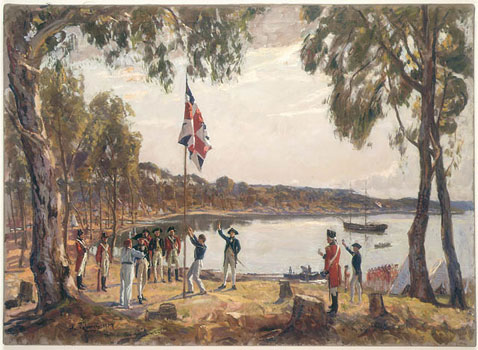
The Founding of Australia, 26 January 1788, by Captain Arthur Phillip R.N., Sydney Cove. [Original oil sketch (1937) by Algernon Talmadge R.A. ML1222]
– Here’s a map of the journey taken by the First Fleet.
– Search for the names of the convicts on the First Fleet here
As a side note, if you find a convict if your family history, you have Australian royalty (as it’s known). However if you can lay claim to being descended from a First Fleet convict, then you have ‘true’ Australian royalty.
**[Please Note: the numbers vary depending on the report. But there were over 710, and can be up to 780]
My First Hannaford Family in Australia
For Australia Day this year I decided to write about the Hannafords, who are one of my immigrating families. Or more specifically I should say, about Susannah Hannaford (nee Elliott), who is truly the matriarch of the family, and her children.
I admit I am in awe of Susannah, in some ways anyway. She was a widow by age 48, not an easy thing for anyone, but then to pack up all of your belongings and move to the other side of the world, to a colony that had only been founded a few years before, with her six children, leaving her family, friends and whole life behind, to start again from scratch. I can’t even begin to think of what that would be like or how she managed it. But she survived. So did her children, and now her descendants number the thousands.
But let’s go back a little bit first.
Back in Devon …
Susannah Elliott was born in 1790 in the market town of Totnes, in Devon, England. Meanwhile the Hannaford family (the ones I’m writing about anyway), grew up just four miles away in the little town of Rattery. I mention that as the Hannaford name in Devon is much like Smith or Brown everywhere else. Hannafords are everywhere!
When Susannah was 30 years old, she married William Hannaford (one from the neighbouring parish in Rattery), and who was actually a few years younger than her. Sadly William died at age 42, leaving Susannah with six children ranging in age from 17 down to 6.
Devon at that time (actually probably England at that time) had limited employment opportunities, and with high taxes (land tax and window tax for instance), it would seem that emigrating to a new land offered better prospects than staying in Devon.
The Voyage and Arrival …
So in 1840 Susannah and her clan together with 164 other passengers, boarded the “Brightman”, which was a three-masted barque which sailed from London, to Plymouth, and on to South Australia, making a quick voyage in just 106 days. Again, I can’t envisage what that would have been like. The closest I’ve been to this is a large cruise ship for 21 days which doesn’t even vaguely compare in any way whatsoever!
The Verco’s were also aboard the Brightman, and the following is an extract from the “Early Recollections of Sir Joseph Verco” which was written around 1930.
“The Brightman was a dry and comfortable ship. The bunks were arranged athwart ships along the sides of the vessel leaving a passage down the middle of the ‘tween decks. If in bed the passengers had to shift pillows from one end of the bunk to the other else he would be lying with his head down and his feet at a much higher level. Captain Nockells was a religious man conducting regular Sunday services, and he never failed to close with Psalm 139 verses 7-12. He would then invoke the blessing of God on the ship and those within, followed by the benediction. The Brightman made good passage of only 106 days. Keeping as much to the eastward as possible on the way south to avoid the dreaded Cap San Roque and its leeward currents. They sailed close round the Cape of Good Hope, then well to the north … and anchored in Holdfast Bay on 10 December 1840.
From the time of anchoring to the time of departure from the ship, there was a delay of seven days for some passengers. Boats transported the passengers and their luggage to land. Many floatable articles, such as wooden framed houses, manufactured and packed in England for immediate erection on landing in Australia, were simply tossed overboard and then tided to shire. All this took time and meant a long and tedious wait onboard for passengers.
When not concerned with the activity going on around them, those onboard found themselves preoccupied with thoughts of what awaited them beyond the shores amid the dense forest of trees and scrub … As it was they could see hundreds of natives moving along the shoreline. More than once they had been startled by the noise of a corroboree, one of which had been followed by fierce fighting resulting in many naked warriors being speared to death. Even at a distance it was somewhat frightening, but still more unnerving had been the screaming and yelling of the lubras as they mourned their dead.”
From the ship at Holdfast Bay (now Glenelg) it was a case of making the trip to Emigration Square in Adelaide, approximately 12 kilometers away, and with no roads. For many it was a case of walking the trip while for others they travelled by bullock dray. Emigration Square, situated on the Parklands, just west of Hindley Street contained 30-40 wooden huts in 1839-40, which were made for newly arrived emigrants to have a place to stay until they moved on.
Settling in South Australia …
The records show that the first house Susannah bought in South Australia was a 2 acre property at Unley in 1841. This was a small cottage and she established a mini farm on the land. By this time her two oldest two sons, Richard and George, went off cattle herding for the South Australian Company. And no doubt it was during one their travels that they heard of “fertile land with springs and running water 25 miles from Adelaide”. So George and his friend from the ship, James Verco, set out to find this land, and found it at Cudlee Creek, in the Adelaide Hills.
George was impressed with it, so much so that Susannah immediately bought land there, and in 1849 had a cottage built from stone quarried on the property. They named this property “Hatchlands” after the family property in Devon “Hatchland”. And this was the start of the Hannaford’s at Cudlee Creek. And today (six generations and 168 years later), they are still in the region.
As her family grew up and got their own properties, you will find descendants of Susannah’s living at Bonney’s Flat, Birdwood (Blumberg), Riverton, Saddleworth and of course Cudlee Creek (all in South Australia). And some of the property names associated with the family are ‘Broad Oak’, ‘Mount Bera’, ‘Riverside’, ‘Dingo Vale’, ‘Wattle Vale’, ‘The Briars’ and ‘Greenhills’.
The Hannaford’s have been heavily involved in the Fruitgrowers and Agricultural Associations for many years, and were known for their top class and prize winning apples. Some even winning international prizes. And I’m proud to say that today there are still family members running these generations-old apple orchards.
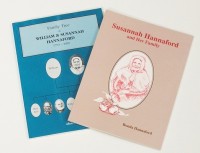 Of course Susannah and her family’s story doesn’t stop there. There are many achievements and noteworthy things from numerous descendants, but it’s too much for this post. But for anyone that does want more info on the family, I suggest getting a copy of both the following books, as they contain plenty of detail:
Of course Susannah and her family’s story doesn’t stop there. There are many achievements and noteworthy things from numerous descendants, but it’s too much for this post. But for anyone that does want more info on the family, I suggest getting a copy of both the following books, as they contain plenty of detail:
– Susannah Hannaford and her Family
– The Family Tree of William and Susannah Hannaford 1790-1990
This chart below shows Susannah and William Hannaford, their seven children (the first one died in infancy), together with their grandchildren. Seeing this you’ll understand WHY there are so many Hannaford’s around now.
Susannah Hannaford (1790-1861)
Truly a pioneer
And the matriarch of an incredible clan

